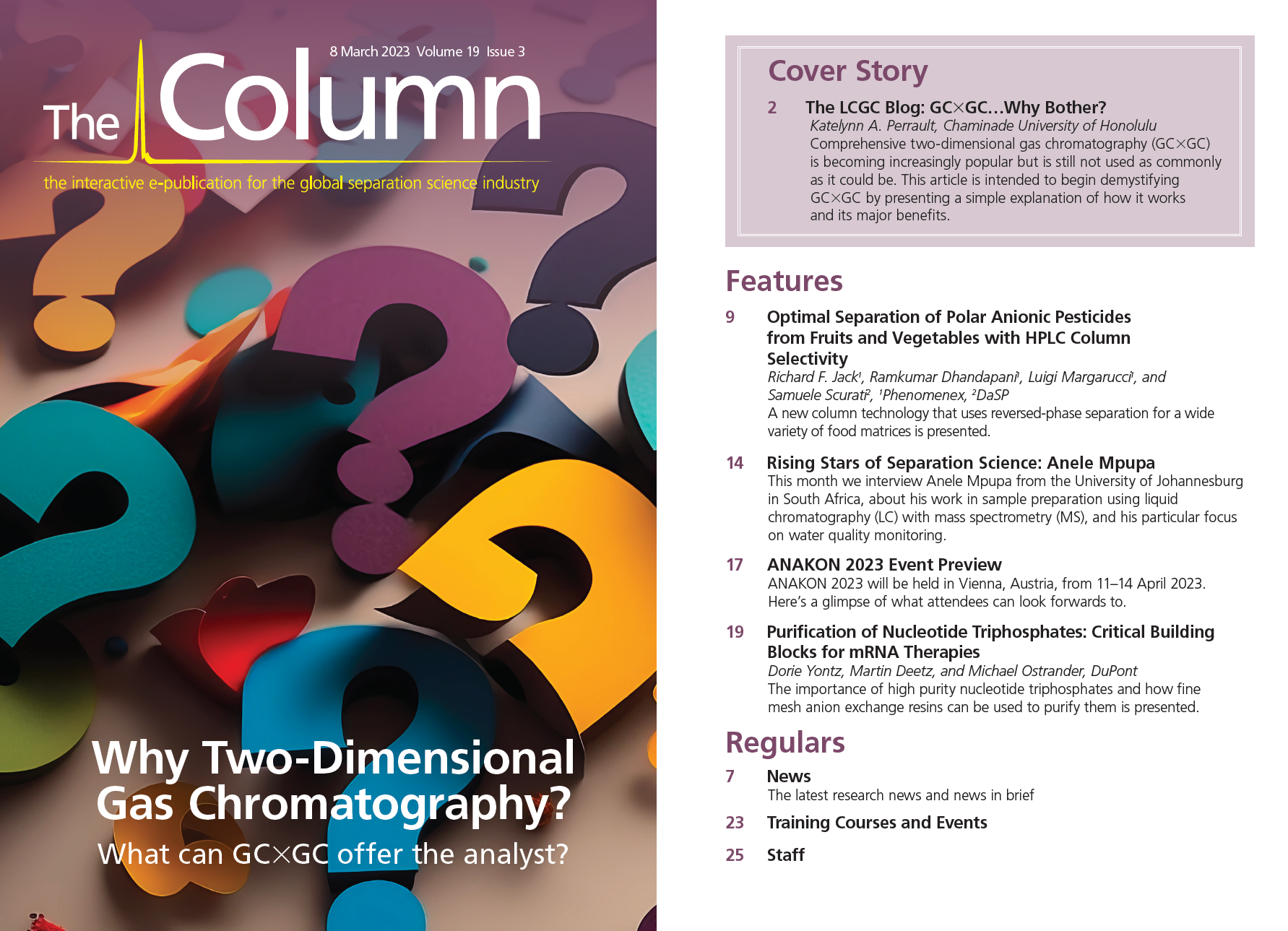Optimal Separation of Polar Anionic Pesticides from Fruits and Vegetables with HPLC Column Selectivity
The presence of ionic pesticides found in foods has increased in recent years. Because of their chemical properties their identification and quantification present unique analytical challenges compared to hydrophobic pesticides. Several approaches including ion-exchange chromatography (IEC), hydrophilic interaction liquid chromatography (HILIC), and ion chromatography (IC) have been developed to facilitate chromatographic resolution and to approach different matrices. This article presents a new column technology that uses reversed phase separation and offers excellent peak shape, resolution, and robustness
for a wide variety of food matrices.
The analysis of polar pesticides presents multiple challenges, including adequate retention, separation of critical pairs, and reproducibility, to name just a few. In addition, food matrices can add additional challenges due to the presence of complex matrix components including pigments, fats, and sugars that can interfere with the analyte of interest. Often, polar anionic analytes such as glyphosate will utilize QuEChERS (quick, easy, cheap, effective, rugged, and safe) or QuPPE (quick polar pesticides) sample preparation techniques, followed by hydrophilic interaction liquid chromatography tandem mass spectrometry (HILIC–MS/MS) methods for chromatographic retention and separation. Historically, these methods are not user-friendly, and lack the reproducibility necessary for a commercial application. Glyphosate (N-[phosphonomethyl]glycine) is a widely used broad-spectrum systemic herbicide and crop desiccant. Previously, glyphosate was considered as safe and not toxic to humans (1–2). However, since the International Agency for Research on Cancer (IARC), a branch of the World Health Organization, classified glyphosate as a probable human carcinogen (3) it is now of concern. In this study, a unique selectivity that provides optimal separation of various anionic polar pesticide classes including glyphosate, chlorate, perchlorate, ethephon, phosphoric acid-based pesticides, and N-Ac‑Glu pesticides will be presented. Phosphonic acid is a degradation product of the fungicide fosetyl aluminum (fosetyl‑Al). This study will demonstrate robust polar pesticide analysis from several food matrices.
A mixed mode column with characteristics that make it amenable to both HILIC and reversed-phase chromatography has been introduced. These properties allow strong retention of polar compounds in HILIC and reverse-phase separation modes. This column is complementary for both reversed phase and normal mode, and is compatible in both 100% aqueous and 100% organic phases. The column allows the analyst to use a single column for both HILIC and reversed‑phase modalities by reversing the gradient without changing the mobile phase.
Method
Normally, HILIC conditions are used for the analysis of extreme polar pesticides. The chromatogram in Figure 1 shows the separation of common pesticides including chlorate and perchlorate in less than 5 min using reversed-phase mode. Excellent peak shape and resolution was achieved for all compounds.
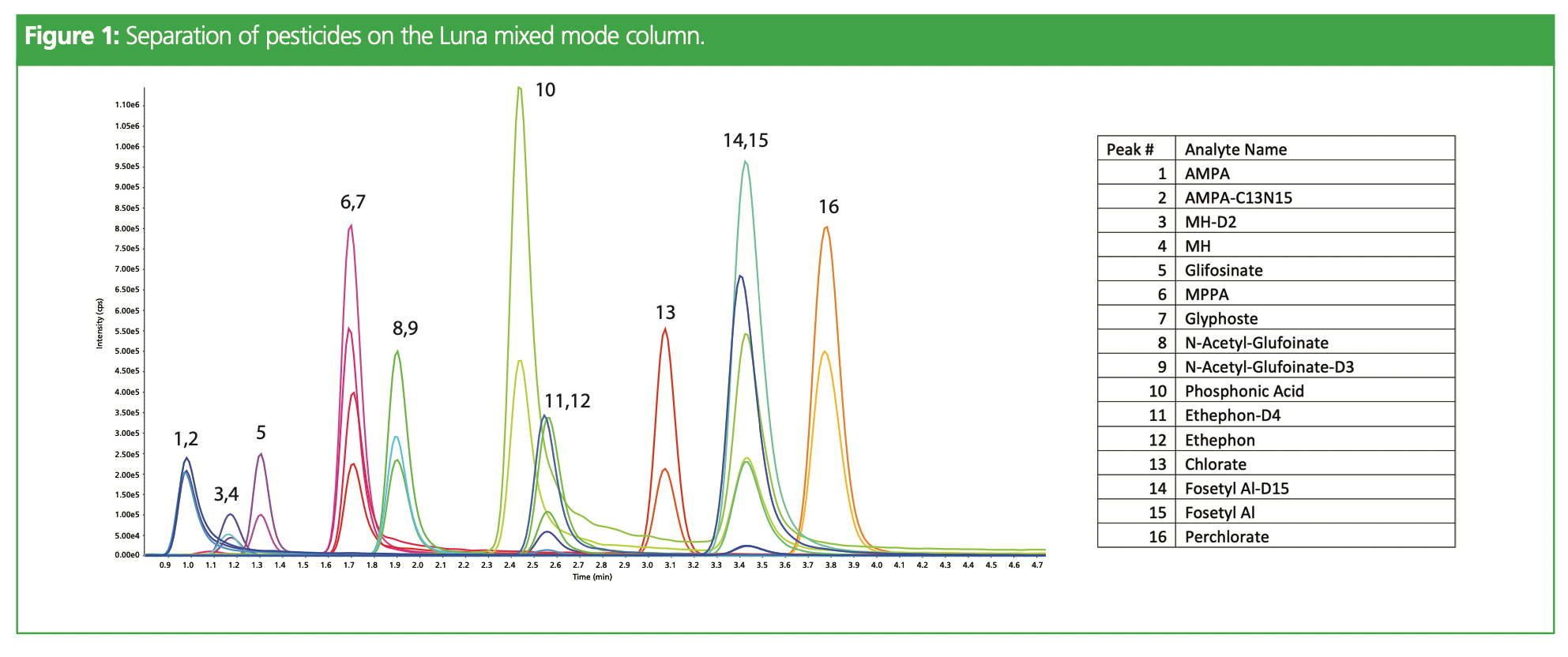
Experimental Conditions: particle size: 3 µm; dimension: 100 × 2.1 mm (Phenomenex); guard column SecurityGuard Ultra Cartridge (Phenomenex); mobile phase: A: 0.3% formic acid in water, B: 0.3% formic acid in acetonitrile; gradient: 0 min 2%B, 0.5 min 2%B, 6.0 min 20%B, 7.0 min 90%B, 9.0 min 90%B, 9.1 min 2%B, 12 min 2%B; flow rate: 0.3 mL/min; injection volume: 1 µL; temperature: 40 °C; MS/MS detector: Sciex 7500.
Analysis of Pesticides from Food Matrices
In order to assess the effect of food matrices on column performance, sample extracts of spiked food extracts were tested. The sample preparation steps followed the “Quick Method for the Analysis of Numerous Highly Polar Pesticides in Foods of Plant Origin” (QuPPe-PO) (4). The food matrices tested were grain, kiwi, zucchini, arugula, and soy. The chromatograms (Figures 2 and 3) show the peaks for raw, 10, and 100 ppb spikes for each of the analytes from the matrices above after QuPPe-PO extraction. The peak shapes for both glyphosate and ethefon are both very sharp and well above baseline for accurate quantification. Figure 2 shows glyphosate recovery from raw matrix with an accuracy between 70–120%, even in a matrix (grain) that contains glyphosate at 3.27 ppb. A similar behaviour was observed for ethephon (Figure 3). The accuracy range is in agreement with that recommended by SANTE 11312/2021 (5). The same results were seen for all the pesticides tested in Figure 1 (data not shown).
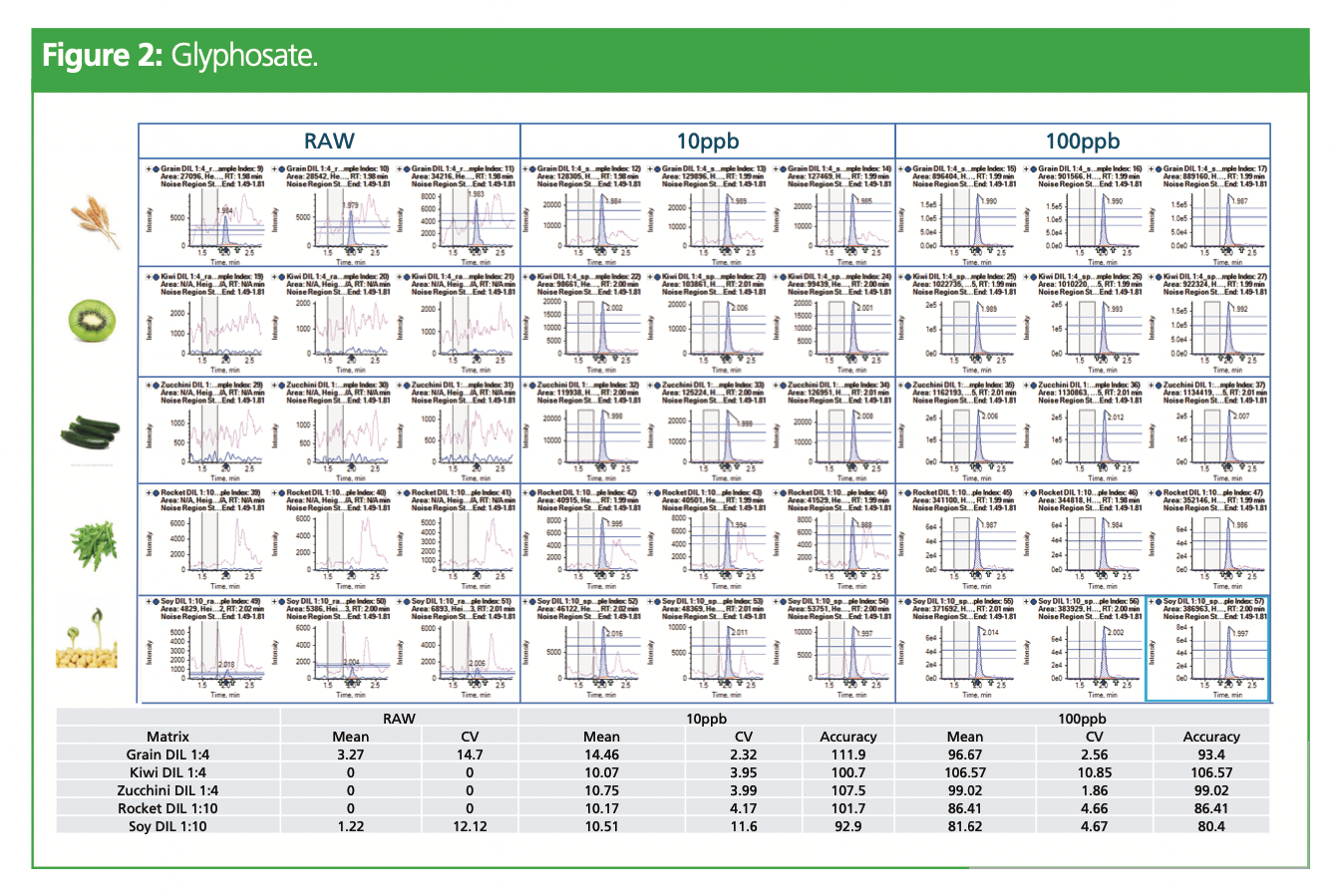
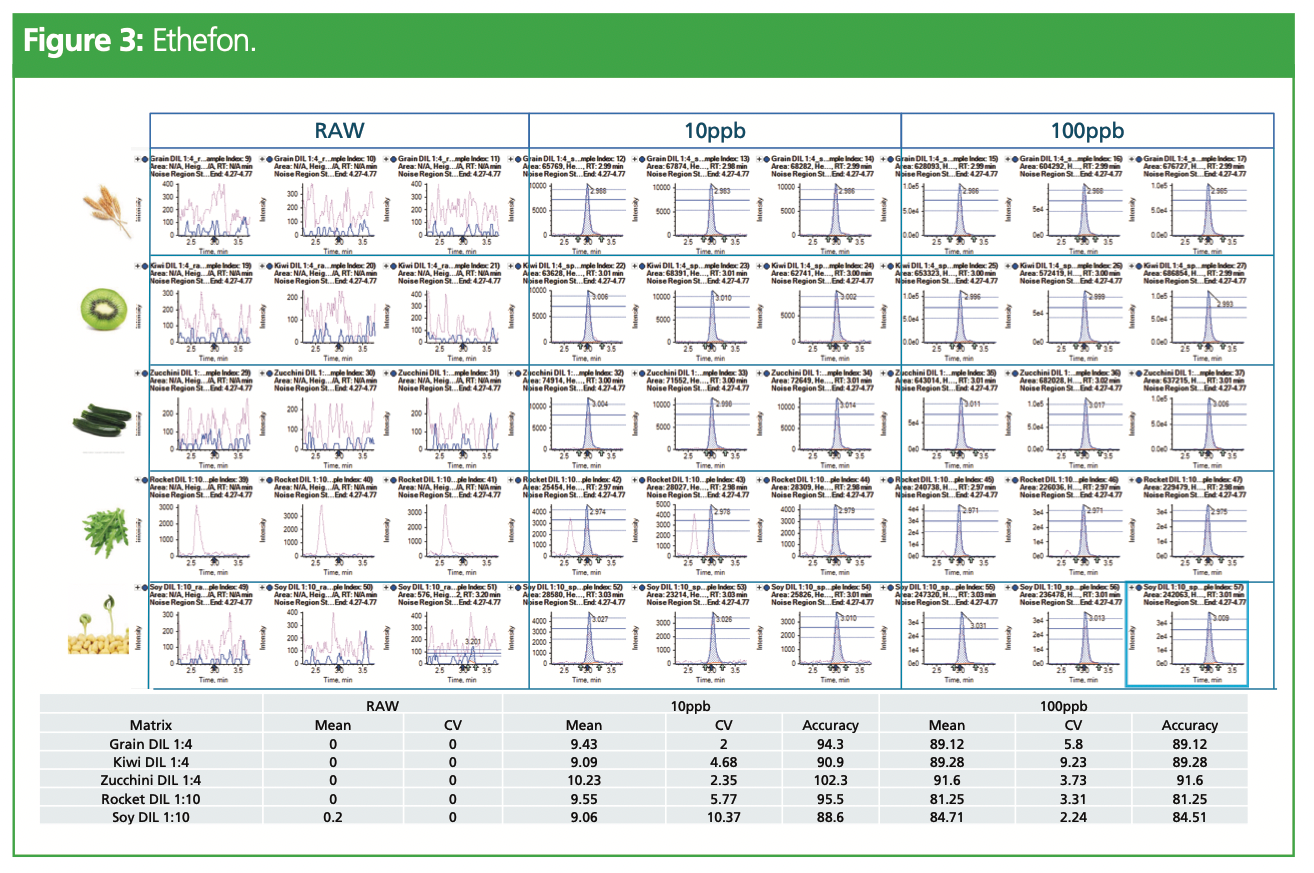
Results and Discussion
Column selectivity plays an important role in providing enhanced chromatographic resolution for critical pairs. In addition, retention of extremely polar analytes is very challenging. This study has presented the optimal separation of polar pesticides using a mixed mode column. Polar interactions in the reverse-phase mode were used to obtain enhanced retention of polar pesticides. Baseline separation between phosphoric and phosphonic acid was achieved, avoiding false positive results in the determination of phosphonic acid. The chromatogram of standards shows excellent retention and selectivity for polar pesticides (Figure 1). Traditional reversed‑phase columns do not retain analytes such as glyphosates, which can fall in the ion suppression zone in real samples and hence show as false positives or negatives. Enhanced polar selectivity from the un-endcapped silica base and the amide ligand provided excellent retention, which is evident from retention of the polar pesticides that range from 0.7 to 6.6 min. Sample extracts from grains, kiwi, zucchini, arugula, and soy were analyzed with this method, followed by spiking them with known concentrations of polar pesticides. The method proved to be precise, robust, and accurate for polar pesticides. Unlike traditional HILIC methods that suffer in terms of re-equilibration time and retention time shifting, this method provided more stable retention times and faster re‑equilibration because the retention of very polar compounds was performed in reverse phase by utilizing polar interactions from the stationary phase (6). Thus, the developed method could be used in laboratories running routine polar pesticide analysis.
References
- European Food Safety Authority (EFSA), Conclusion on the Peer Review of the Pesticide Risk Assessment of the Active Substance Glyphosate. EFSA Journal 2015, 13, 4302. DOI: 10.2903/j.efsa.2015.4302
- United States Environmental Protection Agency. Glyphosate. https://www.epa.gov/ingredients-used-pesticideproducts/glyphosate
- International Agency for Research on Cancer (IARC), Evaluation of Five Organophosphate Insecticides and Herbicides. IARC Monographs 2015, 112.
- QuPPe-PO Method for Products of Plant Origin. https://www.eurl-pesticides.eu/docs/public/tmplt_article.asp?LabID=200&CntID=1115&Theme_ID=1&Pdf=False&Lang=EN
- EU Reference Laboratories for Residues of Pesticides, Analytical Quality Control and Method Validation Procedures for Pesticide Residues Analysis in Food and Feed SANTE 11312/2021. https://www.eurl-pesticides.eu/userfiles/file/EurlALL/SANTE_11312_2021.pdf
- McCalley, D. V. Hydrophilic Interaction Liquid Chromatography: An Update. LCGC Europe 2019, 32 (3), 114–125.
Richard F. Jack is global market development manager for the environmental and food markets at Phenomenex Corporation. He has over 18 years experience with chromatography and mass spectrometry for the environmental, semiconductor, chemical, and pharmaceutical industries. Richard collaborates with global regulatory agencies to develop validated methods through new applications, instrumentation, column chemistries, and software. Richard is a former EPA scientific advisor for the EPA’s panel on hydraulic fracturing, and a coauthor for EPA 557 and 557.1 along with ASTM D8001 and updates to D4327 and D6919 methods. He is currently the second vice chairman for the ASTM D19 subcommittee on water analysis. Richard was previously a vertical marketing manager with Thermo Fisher Scientific, Dionex, and Hitachi High Technologies, where he designed analytical instrumentation, including IC and high performance liquid chromatography (HPLC) systems, pumps, autosamplers, and a variety of detectors. Richard received his Ph.D. in biochemistry and anaerobic microbiology from Virginia Tech University in Blacksburg, Virginia, USA, and his master’s in ecology from the University of Tennessee in Knoxville, Tennessee, USA.
Ramkumar Dhandapani has been in the chromatography industry for over 20 years and has hands-on and troubleshooting experience in chromatography. He has earned a master’s degree and doctoral degree in analytical chemistry from Seton Hall University, New Jersey, USA, with specialization in microextractions, multidimensional chromatography, and tandem mass spec techniques. He has developed and validated several regulatory compliant methods in the pharmaceutical, food, and environmental industries. He joined Phenomenex in August 2014 and serves as global product manager at Phenomenex, USA.
Luigi Margarucci began his career at Phenomenex in 2015 as a technical sales consultant. In 2017 he assumed the role of MS specialist and in 2020 he became head of training in the field of chromatography. Since 2021 he has held the role of technical manager for Italy. He was a research fellow at the University of Salerno, Italy, and in 2009 he moved to the University of Utrecht, Netherlands. To date, he is the author of 27 scientific publications, and has written and presented a large number of seminars related to analytical techniques such as HPLC, gas chromatography (GC), and solid-phase extraction (SPE).
Samuele Scurati received a degree in medicinal chemistry and a PhD in biochemistry in 2008. He then started his career as an application field marketing specialist for clinical and toxicology, developing new applications of LC–MS in the clinical market. In 2011 he became one of the founders of DaSP project, working as an application scientist to develop innovative LC–MS methods. He has published several scientific articles and participated in many national and international conferences.
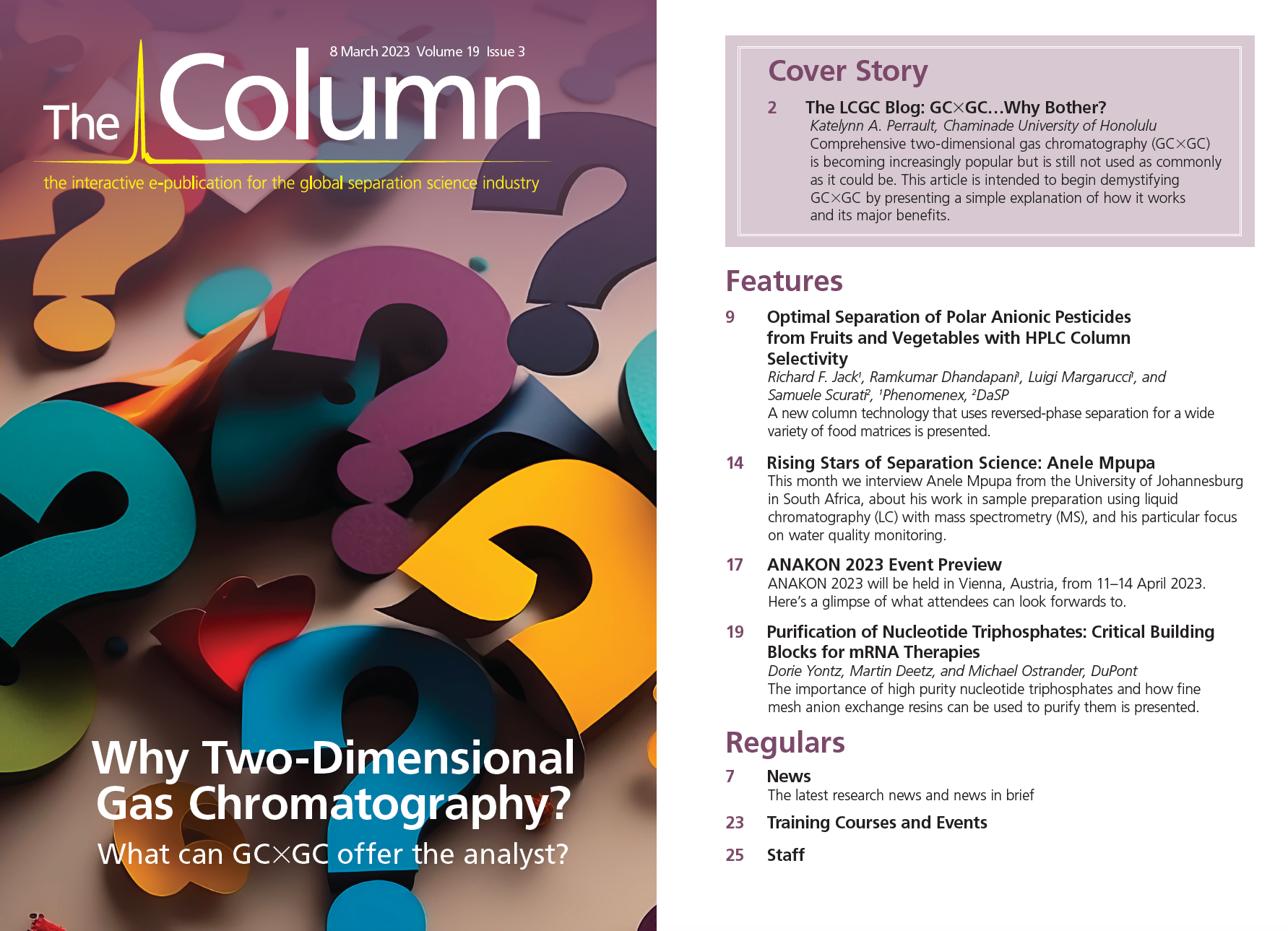
Analytical Challenges in Measuring Migration from Food Contact Materials
November 2nd 2015Food contact materials contain low molecular weight additives and processing aids which can migrate into foods leading to trace levels of contamination. Food safety is ensured through regulations, comprising compositional controls and migration limits, which present a significant analytical challenge to the food industry to ensure compliance and demonstrate due diligence. Of the various analytical approaches, LC-MS/MS has proved to be an essential tool in monitoring migration of target compounds into foods, and more sophisticated approaches such as LC-high resolution MS (Orbitrap) are being increasingly used for untargeted analysis to monitor non-intentionally added substances. This podcast will provide an overview to this area, illustrated with various applications showing current approaches being employed.
Common Challenges in Nitrosamine Analysis: An LCGC International Peer Exchange
April 15th 2025A recent roundtable discussion featuring Aloka Srinivasan of Raaha, Mayank Bhanti of the United States Pharmacopeia (USP), and Amber Burch of Purisys discussed the challenges surrounding nitrosamine analysis in pharmaceuticals.






